L'Oréal, the world leader in cosmetics, prides itself on being a model of social and environmental responsibility. It is even one of its most advanced marketing arguments. However, if we look a little further than the rhetoric of the company's communicators, we can see that the leader in beauty products willingly agrees with scientific studies and collateral damage on the environment to sell its products. Academic Thibault Lescuyer conducted an in-depth investigation into L'Oréal's sunscreens and their impact on the environment in general and on coral reefs in particular. Diving into the world of beauty, at all costs.
In June 2019, L'Oréal, the global cosmetics giant, launched an new websiteThe name "at the heart of our products". The initiative is part of a desire for transparency - a cardinal principle of Corporate Social Responsibility (CSR) - on the components used. Palm oil, parabens, hair dyes, nanoparticles... some twenty components are presented.
Objective: to reassure users about their safety. Among these controversial components are sunscreens. As L'Oréal acknowledges, some sunscreens - the company does not specify which ones - are accused of having negative impacts on human health: skin allergies, endocrine disruption, even cancer.
Sunscreens have also raised a wave of environmental concern, since several scientific studies have identified that UV filters can accelerate the coral bleaching. Would these reservoirs of biodiversity, already victims of global warming, be further damaged by bathers' creams? The subject has aroused excitement and abundant media coverage.
These suspicions and accusations, the site " at the heart of our products of L'Oréal does not deny them, it summarizes and refutes them with scientific arguments.
Here is the central statement written by the company's communicators on the page concerning the sunscreen products :
Why not enjoy unlimited reading of UP'? Subscribe from €1.90 per week.

In support of this statement, the firm's communications staff include a link to the term "scientific community", which refers to a academic paper in English, written mostly... by L'Oréal staff researchers.
L’post was published in the scientific journal Coral Reef in February 2019. Its title is: "Photochemical response of the scleractinian coral Stylophora pistillata to some sunscreen ingredients". It is a study conducted on a variety of hard coral, Stylophora pistillata. This coral was exposed in the laboratory to several sunscreens without suffering "any adverse effect on the photosynthetic activity of corals", according to the L'Oréal press release published at the same time.
But doesn't the fact that five out of the eight researchers are L'Oréal employees reveal a problematic conflict of interest? Is it correct to equate a single scientific study and a single article with the entire "scientific community"? These are the questions we wanted to answer. We also wanted to question the possibility of a "transparency communication" that takes science into a controversial area where industrial and financial stakes are high.
Five out of eight researchers affiliated with L'Oréal
Of the eight researchers in the study on which L'Oréal bases its argument, three are researchers at the Monaco Scientific Centre, a centre funded by the principality. Among them, Denis Allemand, scientific director of the Monaco centre, which 'lent' the corals for the study, refutes the idea that the study is biased:
"All the figures in the biological part of the article are obtained by our researchers. We published what we wanted and were not paid by L'Oréal.
The other five authors worked in particular on the precise measurement of the concentration of sun filters in seawater, something that scientists in Monaco say they do not know how to do. These five researchers are employees of L'Oréal Recherche et Innovation, which means a direct financial and subordinate link with the sunscreen manufacturer.
To say the least, this does not put them in a position of independence and impartiality. Doesn't their employer have an obvious interest in the study results demonstrating an absence of toxicity? Even if, perhaps, they were to use a methodology that would minimize the risk of an adverse conclusion?
We have asked L'Oréal whether this situation does not present a conflict of interest. Marc Léonard, director of the environmental research laboratory, answered us:
"It is clearly stated in the "conflict of interest" section of the scientific article that the researchers of the Monaco Scientific Centre and co-authors of this article do not have a conflict of interest. »
Let us be clear: the salary dependence of the five co-authors does not in itself disqualify the results of the study. These results could be robust. However, this calls for a certain amount of caution about the study. It could be said, for example, that further investigation, particularly by researchers not paid by L'Oréal, is necessary.
To fight against disinformation and to favour analyses that decipher the news, join the circle of UP' subscribers.
A unique scientific study
L'Oréal does not follow this path of transparency, which casts a cloud over the robustness of its CSR communication.
Because the company's argument, on its page "at the heart of our products", assimilates a single academic article to the entire "scientific community". However, the so-called unanimity of the scientific community does not exist.
Among the many scientists working on corals, some are studying the influence of global warming on bleaching, which is proven, and others are studying human pollution. Several researchers are working specifically on the impact of sunscreen filters.

This is particularly the case for Professor Roberto Danovaro and his colleague Cinzia Corinaldesi from the Università Politecnica delle Marche in Ancona, Italy. They are the authors of a large number of articles published in scientific journals.
Contacted on the phone, these researchers contradict L'Oréal: some sun filters would be very harmful to corals and the study co-conducted by L'Oréal would not be robust enough to draw a definitive conclusion.
Professor Danovaro, like his co-author Cinzia Corinaldesi, read the L'Oréal study. "I have never seen a paper with so little information on experimental procedures," he says.
Both researchers are critical of the methodology used. In particular, they find it problematic that the study was limited to looking at the photosynthetic activity of algae that live in symbiosis with the coral, without looking at viral infections or the state of coral tissue. However, as Roberto Danovaro points out:
"Corals are very susceptible to viral and herpes-like infections. However, many sunscreens cause an explosion in the number of viral infections, leading to coral bleaching or death. This has been confirmed by numerous studies. »
We have asked L'Oréal for its opinion on these claims. The Danovaro and Corinaldesi studies "suffer from major methodological biases", according to Marc Léonard, director of L'Oréal's environmental research laboratory, who reports doses tested that are out of proportion to reality and a lack of a dose-response relationship on viral infections.
However, the studies of the two Italian researchers have been published in peer-reviewed journals. In addition, other scientific studies have identified problematic impacts of sunscreens on corals at various doses and under various experimental conditions. We are therefore typically faced with a scientific controversy on a subject that is still emerging and complex.
Scientific controversy
The scientific controversy is all the more visible when you dive as close as possible to the UV filters. These filters are synthetic molecules, often used in mixtures in creams. L'Oréal's "at the heart of our products" page mentions five of them, used by its Vichy and La Roche-Posay brands, in particular.
Three filters are called "organic" because they contain carbon atoms: drometrizole trisiloxane (marketed as "Mexoryl-XL"), octocrylene and bis-ethylhexyloxyphenol methoxyphenyl triazine; and two filters are called "mineral" because they contain carbon atoms: titanium dioxide and zinc oxide.
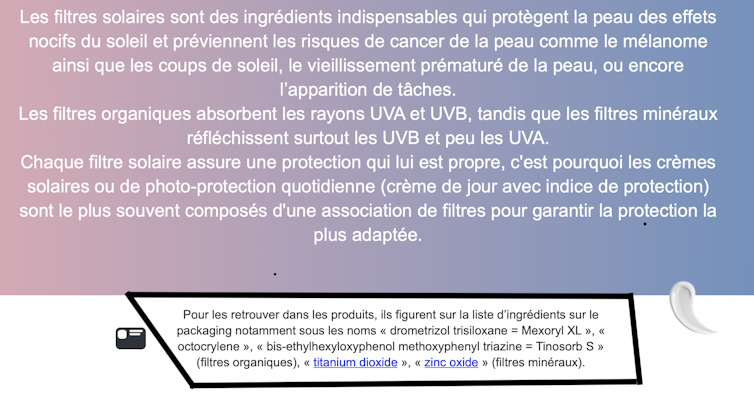
Reading L'Oréal, one understands that the five filters mentioned do not contribute to coral bleaching and do not have a negative impact on the environment. However, two of these filters do not appear to be as harmless as the company would have us believe. These are octocrylene and zinc oxide.
Octocrylene is toxic in fresh water.
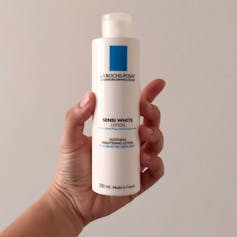
Octocrylene is a filter used in sunscreens from Vichy and La Roche-Posay, two brands belonging to the L'Oréal group. However, "investigations have shown that this filter is toxic to aquatic organisms with long-term effects. The compound can lead to bioaccumulation in various organisms," says Cinzia Corinaldesi, Professor Danovaro's colleague.
That is what a study published in 2019 led by researcher Didier Stien of the Centre national de la recherche scientifique (CNRS), in the journal Analytical Chemistry.
This study concludes that the concentrations of octocrylene in the environment and organisms may have been "grossly underestimated" and calls for "an in-depth assessment of the toxicity of octocrylene and a re-evaluation of its rate of accumulation in the ocean food chain".
Surprised by these contradictory assertions with those of L'Oréal, we asked the company for clarification on the dangerousness of octocrylene.
Marc Léonard acknowledges that this molecule is classified as "dangerous for aquatic life" by the European Union (under the REACH regulation aimed at making the manufacture and use of chemical substances in European industry safer) because of "its chronic toxicity to freshwater invertebrates".
The L'Oréal researcher also relays to us a recommendation from his study: the "most stringent" classifications currently used by the EU for freshwater living organisms "could provide a method for identifying chemicals that require a reassessment of marine risks if released near corals".
In other words, on octocrylene and corals, L'Oréal researchers are much more cautious than their communicating colleagues and the site "at the heart of our products".
Denis Allemand, from the centre of Monaco, is also much more reserved:
"The study is mainly there to propose a rapid test on the photosynthetic activity of corals. It is not said that the products that passed our test can be used without any problem in the environment. At no time do we say that. »
And he is not aware, he tells us, of L'Oréal's public communication of the study results.
Discretion on zinc oxide
Another filter used and tested by L'Oréal is problematic: zinc oxide. A so-called "mineral" filter, zinc oxide was considered a "clean" and safe component at the beginning of 2010. A large number of manufacturers have in fact incorporated it into the composition of their hypoallergenic sun creams.
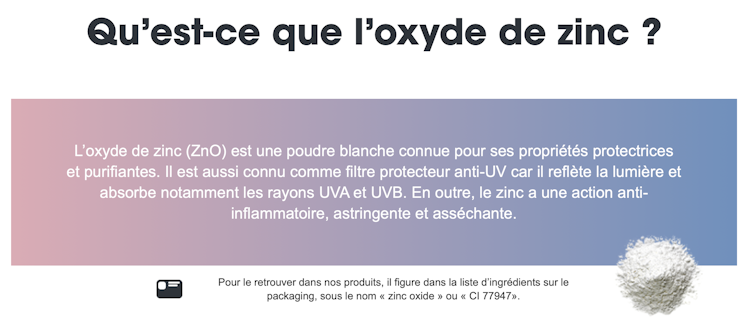
But several recent studies indicate that sunscreens containing zinc oxide, or zinc oxide itself, may aggravate coral bleaching. This is one of the conclusions of thestudy "Impact of inorganic UV filters contained in sunscreen products on tropical stony corals" published in the journal Science of the Total Environment in January 2018. The authors, including Cinzia Corinaldesi, state:
"Zinc oxide (ZnO) causes a rapid whitening and severe coral damage due to altered symbiosis between coral and zooxanthellae algae. ZnO also directly affects symbiotic dinoflagellates (unicellular microalgae) while stimulating microbial presence in the marine water surrounding the corals. »
L'Oréal's scientific article does not deny this impact on coral, on the contrary:
"Our study, like two previous studiesThe study "ZnO and ZnO nanoparticles", clearly shows that zinc oxide ZnO is not the most environmentally friendly compound, and that the impact of ZnO nanoparticles and dissolved ZnO on endangered coral reefs should be seriously investigated.
Again, these conclusions were not repeated in the L'Oréal communication. The communication merely states, on the page of its website dedicated to zinc oxide:

A misleading generalization?
A final problem arises when reading the site "at the heart of our products": the text posted online induces the idea that all the UV filters would not cause any concern to the coral. However, other UV filters such as oxybenzone and octinoxate are still very controversial at the moment. These two filters, which were not included in the L'Oréal study, will be banned from the market. from 2021 in Hawaii and from 2020 on the archipelago of Palau, as a precautionary principle for their coral reefs.
(BFMTV, January 2020)
This ban was decided following the publication of several scientific studiesincluding a laboratory study conducted by Professor Craig Downs and researchers in Eilat, Israel, who say:
"Oxybenzone poses a risk to coral conservation and threatens its resilience to climate change. »
L'Oréal, in our written exchange, questioned Craig Downs' conclusion on the grounds that he had tested higher concentrations of sunscreen than those observed at sea.
Yet a another study The study, led by Dutch researcher Tim Wijgerde, a marine biologist at the University of Wageningen, whose results were made public in 2019, also concluded that oxybenzone would contribute to coral bleaching:
"Our results support the view that semi-chronic exposure to realistic levels of oxybenzone can cause subtle adverse effects on coral health, as well as a pronounced impact on the coral microbiome.
The article presenting these results has not yet been published in a peer-reviewed journal. However, it is one more element calling for the utmost caution, if not the precautionary principle, regarding the use of certain UV filters in the vicinity of corals exposed to heavy tourist traffic.
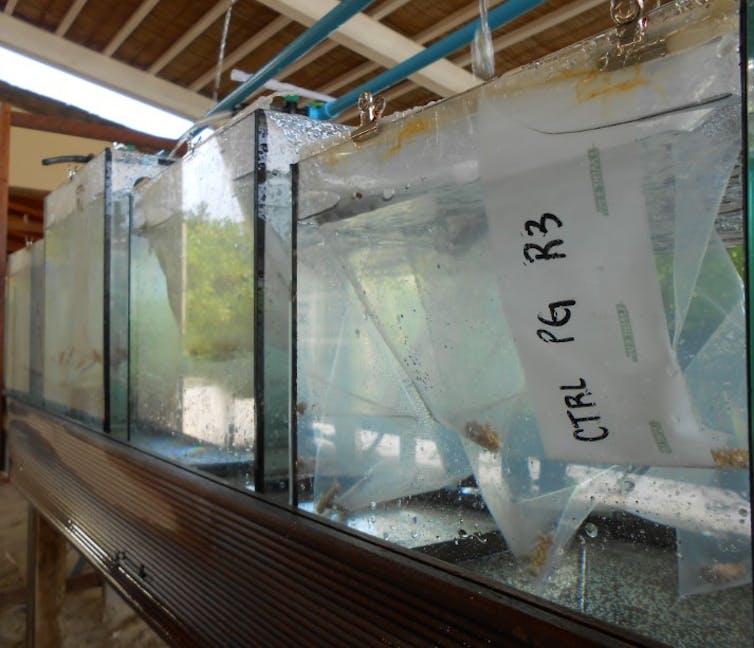
Difficult CSR posture
"A textbook case, this misadventure of science in the land of communication? Our deciphering invites us to reflect on the difficult position of the teams in charge of corporate social responsibility (CSR) policies. They work in companies that want to be "at the cutting edge of CSR" while at the same time being in a growth logic that sometimes leads to "greenwashing".
It is quite possible that CSR practitioners at L'Oréal have been caught between the "hammer" of a bad reputation (knowingly marketing sunscreens that can be harmful to corals) and the "anvil" of scientific manipulation, under the pressure of a "scientific" approach to CSR. business unit (that of sun creams) whose success is indexed to the growth of its turnover.
Today, consolidating its reputation as a company is one of the major determinants of an effective CSR policy. As an example, in a guide document published in 2019, "Our CSR convictions"The French employers' association (Medef) believes that CSR represents "an element of response to the crisis of legitimacy that many economic actors are facing today".
CSR makes it possible to "control reputation risk more effectively". This "good" reputation includes meeting the expectations of customers, who want to be reassured about the impact of products. The new site "at the heart of our products" is entirely in line with this logic. But what if the available scientific answers are partial, complex and uncertain?
Thibault LescuyerProfessor-researcher, co-responsible for the Master M2 in CSR, University of Versailles Saint-Quentin en Yvelines - University Paris-Saclay
This article is republished from The Conversation editorial partner of UP' Magazine. Read theoriginal paper.
![]()

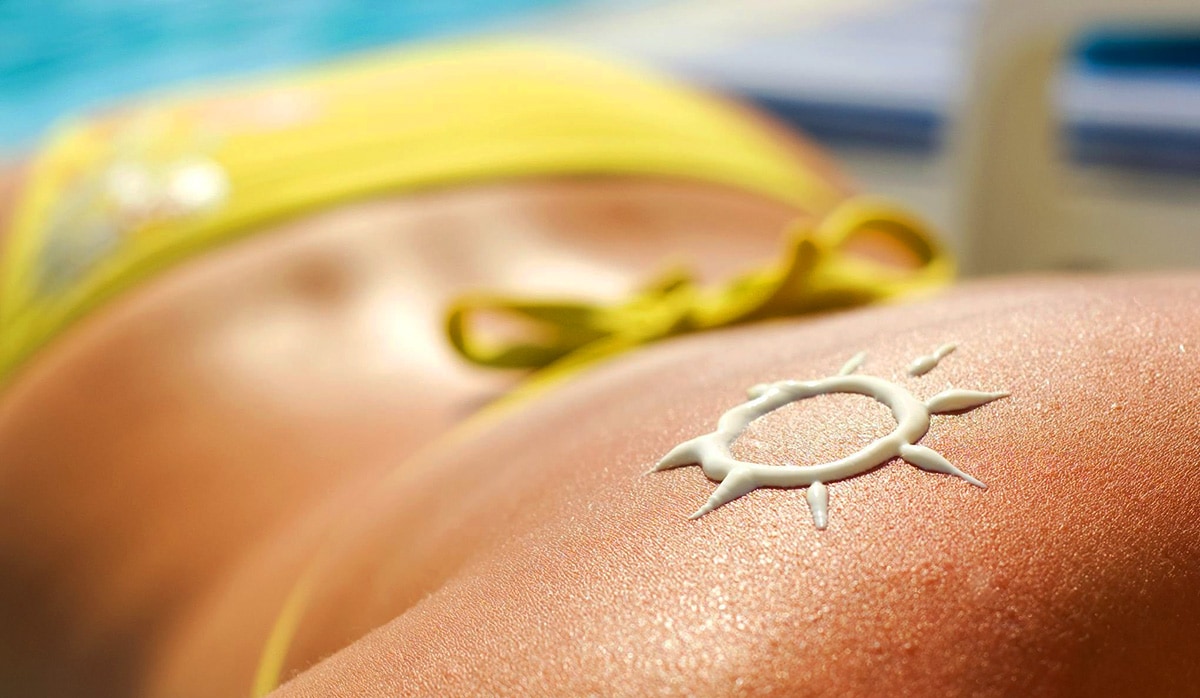











[…] “How L’Oréal is getting the science to sell coral-killing sunscreens” – February 2020 by Up magazine […]
[…] Alerte Greenwashing sur LinkedIn : L'Oréal et l'hypercroissance verte | 24 commentaires. Arnaque à la compostabilité ou greenwashing créatif… ? Dans ce post ( l’agence de pub Creapills 💊 mélange tout : « naturel », « biodégradable », « compostable »… « La marque iGreen Gadgets, annonce-t-elle, a créé des coques d’iPhone biodégradables fabriquées à partir de graines et destinées, une fois usées, à être plantées pour faire pousser du basilic et des marguerites ». Puis, on apprend sur la page-cible ( que ces « coques compostables sont uniquement fabriquées à partir d’éléments naturels et sont ainsi destinées à être plantées… Read more "
[…] lancée en 2007 par L’Oréal, avec pour but principal de réduire le packaging de ses produits. Comment L’Oréal s’arrange avec la science pour vendre des crèmes solaires qui tuent les coraux. Les_grands_groupes_du_luxe_et_des_cosmétiques_sont-ils_à_la_hauteur_face_à_lur_0DavqYs. […]